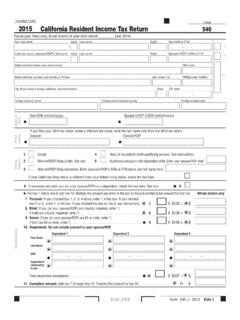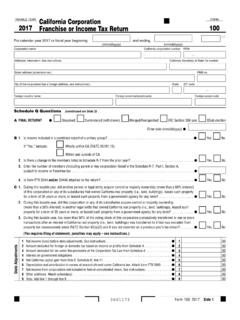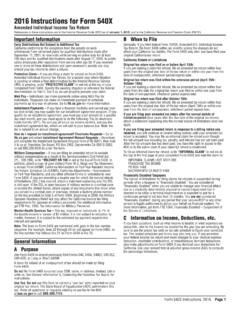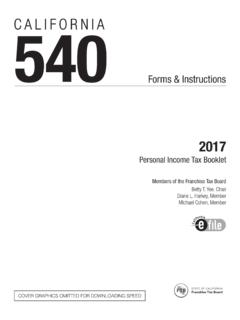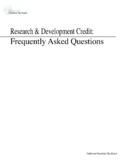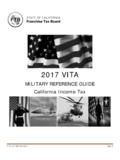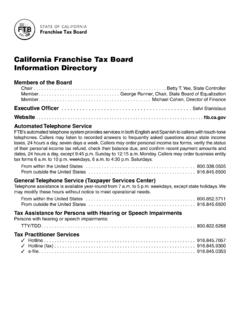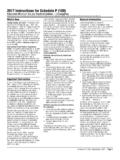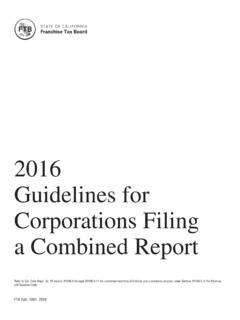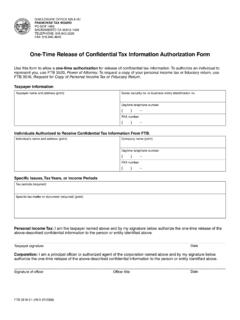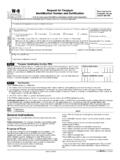Transcription of 2020 California 540 2EZ Forms & Instructions 2020 Personal ...
1 California 540 2EZ Forms & Instructions 2020 Personal income Tax BookletMembers of the Franchise Tax BoardBetty T. Yee, ChairAntonio Vazquez, MemberKeely Bosler, MemberCOVER GRAPHICS OMITTED FOR DOWNLOADING SPEEDPage 2 Form 540 2EZ Tax Booklet ..Table of ContentsWhat s New and Other Important Information for 2020 2 Qualifying to Use Form 540 2EZ 4 Steps to Determine Filing Requirements 4 Instructions for Form 540 2EZ 5 Filing Status Check List 5 Paying Your Taxes 10 Direct Deposit 10 Assembling Your Tax return 11 Mailing Your Tax return 11 Nonrefundable Renter s Credit Qualification Record 12 Voluntary Contribution Fund Descriptions 13 Frequently Asked Questions 14 Additional Information 15 California Use Tax General Information 15 Instructions for Filing a 2020 Amended return 16 Form 540 2EZ, California resident income Tax return 19 Form FTB 3514, California Earned income Tax Credit 23 Instructions for Form FTB 3514 27 California Earned income Tax Credit Table 332020 California 2EZ Single Tax Table 412020 California 2EZ Married/RDP Filing Jointly or Qualifying Widow(er)
2 Tax Table 472020 California 2EZ Head of Household Tax Table 58 Need Assistance? We re Here to Help 63 Franchise Tax Board Privacy Notice on Collection 63 What s New and Other Important Information for 2020 Dependent Exemption Credit with No ID For taxable years beginning on or after January 1, 2018, taxpayers claiming a dependent exemption credit for a dependent who is ineligible for a Social Security Number (SSN) and a federal Individual Taxpayer Identification Number (ITIN) may provide alternative information to the Franchise Tax Board (FTB) to identify the dependent. To claim the dependent exemption credit, taxpayers complete form FTB 3568, Alternative Identifying Information for the Dependent Exemption Credit, attach the form and required documentation to their tax return , and write no id in the SSN field of line 8, Dependents, on Form 540 2EZ, California resident income Tax return .
3 For each dependent being claimed that does not have an SSN and an ITIN, a form FTB 3568 must be provided along with supporting may amend their 2018 and 2019 tax returns to claim the dependent exemption credit. For more information on how to amend your tax returns, see Instructions for Filing a 2020 Amended return on page for Credits Eligibility For taxable years beginning on or after January 1, 2020, California expanded Earned income Tax Credit (EITC) and Young Child Tax Credit (YCTC) eligibility to allow either the federal ITIN or SSN to be used by all eligible individuals, their spouses, and qualifying children. If an ITIN is used, eligible individuals should provide identifying documents upon request of the FTB. Any valid SSN can be used, not only those that are valid for work. Additionally, upon receiving a valid SSN, the individual should notify the FTB in the time and manner prescribed by the FTB.
4 The YCTC is available if the eligible individual or spouse has a qualifying child younger than six years old. For more information, get form FTB 3514, California Earned income Tax Credit, or go to and search for State Tax Filers List For taxable years beginning on or after January 1, 2020, taxpayers will include on their Form 540 2EZ the address and county of their principal residence as part of the FTB s annual reporting requirements to the jury commissioner. Taxpayers that are required to provide this information include persons who are 18 years of age or older and have filed a California resident income tax return for the preceding taxable year. The list of resident state tax filers will be used as one of the source lists for jury selection by the jury commissioner s office. For more information, see specific line Instructions or California Revenue and Taxation Code (R&TC) Sections and Essential Coverage Individual Mandate For taxable years beginning on or after January 1, 2020, California requires residents and their dependents to obtain and maintain minimum essential coverage (MEC), also referred to as qualifying health care coverage.
5 Individuals who fail to maintain qualifying health care coverage for any month during taxable year 2020 will be subject to a penalty unless they qualify for an exemption. For more information, see Specific Line Instructions for Form 540 2EZ, line 27 or get form FTB 3853, Health Coverage Exemptions and Individual Shared Responsibility Child Tax Credit For taxable years beginning on or after January 1, 2019, the refundable YCTC is available to taxpayers who also qualify for the California EITC and who have at least one qualifying child who is younger than six years old as of the last day of the taxable year. The maximum amount of credit allowable for a qualified taxpayer is $1,000. The credit amount phases out as earned income exceeds the threshold amount of $25,000, and completely phases out at $30,000. For more information, see the Instructions for line 24 of Form 540 2EZ, and get form FTB Earned income Tax Credit For taxable years beginning on or after January 1, 2018, the age limit for an eligible individual without a qualifying child is revised to 18 years or older.
6 For more information, go to and search for eitc, or get form FTB 3514. For taxable years beginning on or after January 1, 2017, California conforms to federal law to include in the definition of earned income net earnings from self employment. If you have self-employment income , you cannot use Form 540 2EZ. Get Form 540, California resident income Tax return at or income thresholds have also increased. You may now qualify for the refundable EITC if you have earned income of less than $30,001. Real Estate Withholding Statement Effective January 1, 2020, the real estate withholding Forms and Instructions have been consolidated into one new Form 593, Real Estate Withholding Statement. For more information, get Form X, California Explanation of Amended return Changes For taxable years beginning on or after January 1, 2017, use Schedule X to determine any additional amount you owe or refund due to you, and to provide reason(s) for amending your previous filed income tax return .
7 For additional information, see Instructions for Filing a 2020 Amended return on page Withholding on Severance Paid to Veterans The Combat-Injured Veterans Tax Fairness Act of 2016 gives veterans who retired from the Armed Forces for medical reasons additional time to claim a refund if they had taxes improperly withheld from their severance pay. If you filed an amended return with the Internal Revenue Service (IRS) on this issue, you have two years to file your amended California Funds Withdrawal (EFW) Make extension payments using tax preparation software. Check with your software provider to determine if they support EFW for extension and Credits Applied to Use Tax For taxable years beginning on or after January 1, 2015, if a taxpayer includes use tax on their Personal income tax return , payments and credits will be applied to use tax first, then towards income tax, interest, and penalties.
8 Additional information can be found in the Form 540 2EZ Instructions for line Make tax time less taxing! Check MyFTB for information about your FTB-issued 1099-Gs, Report of State income Tax Refund; 1099-INTs, Statement of Interest income ; California wage and withholding data; and more! Go to and login or register for 540 2EZ Tax Booklet 2020 Page 3 Direct Deposit Refund You can request a direct deposit refund on your tax return whether you e-file or file a paper return . Be sure to fill in the routing and account numbers carefully and double-check the numbers for Deposit for ScholarShare 529 College Savings Plans If you have a ScholarShare 529 College Savings Plan account maintained by the ScholarShare Investment Board, you may have your refund directly deposited to your ScholarShare account. Please visit for Electronic Payments You are required to remit all your payments electronically once you make an estimate or extension payment exceeding $20,000 or you file an original tax return with a total tax liability over $80,000.
9 Once you meet this threshold, all subsequent payments regardless of amount, tax type, or taxable year must be remitted electronically. The first payment that would trigger the mandatory e-pay requirement does not have to be made electronically. Individuals who do not send the payment electronically will be subject to a 1% noncompliance can request a waiver from mandatory e-pay if one or more of the following is true: You have not made an estimated tax or extension payment in excess of $20,000 during the current or previous taxable year. Your total tax liability reported for the previous taxable year did not exceed $80,000. The amount you paid is not representative of your total tax more information or to obtain the waiver form, go to Electronic payments can be made using Web Pay on the FTB s website, EFW as part of the e-file tax return , or your credit card. Registered Domestic Partners (RDP) Under California law, RDPs must file their California income tax return using either the married/RDP filing jointly or married/RDP filing separately filing status.
10 RDPs have the same legal benefits, protections, and responsibilities as married couples unless otherwise you entered into a same-sex legal union in another state, other than a marriage, and that union has been determined to be substantially equivalent to a California registered domestic partnership, you are required to file a California income tax return using either the married/RDP filing jointly or married/RDP filing separately filing status. For purposes of California income tax, references to a spouse, husband, or wife also refer to an RDP, unless otherwise specified. When we use the initials RDP they refer to both a California registered domestic partner and a California registered domestic partnership, as applicable. For more information on RDPs, get FTB Pub. 737, Tax Information for Registered Domestic of Household California requires taxpayers who use head of household (HOH) filing status to file form FTB 3532, Head of Household Filing Status Schedule, to report how the HOH filing status was you do not attach a completed form FTB 3532 to your tax return , we will deny your HOH filing status.
